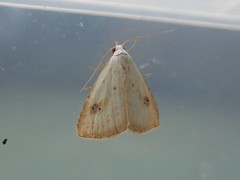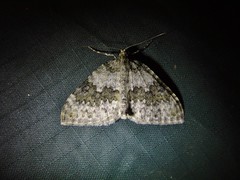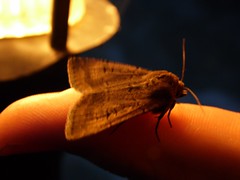
The retreating snow unburdens the lawn
Merry Easter everybody!
It may be the last week of March, but in the UK and particularly here in Nornia and in Scotland, the white dragon of winter has mounted a late attack, making it more like Christmas than Easter, and even then not very festive for the hundreds of families suffering power outages, 16ft snowdrifts and huge losses of livestock.
The snow fell about half a foot to a foot in my garden but a few days of sunshine is thawing it well. The daffodils got a bit flattened by the weight but are mostly OK, with the petals pushing through and not far off blooming. Leafburst has been well underway on the elder and the roses for weeks, and are both now awaiting the onslaught of aphids. The black aphids which came to the elder last year provided a good amount of honeydew which the moths went mad over, including a Peach Blossom, so I’m hoping this year is a repeat!
There’s a bit to catch up on from this past month, and this will probably be my longest post for a while – or should be, since it’s That Time Of Year again, when exams take over and lepidoptery takes a hit. Most of my major exams are over by the second week of June, but anyone who follows this blog knows how hollow some of my promises to write-buckets-when-I-have-the-time have been! So we’ll see how things go.
Big changes are happening in my life this year, most notably I’m moving to St Andrews in September to take a four-year biology degree (with a bit of physics and chemistry on the side). Before that, I’m going to Switzerland. For a two-week mountaineering expedition. In July, when it could well be total lepidopteran overload. It hasn’t quite sunk in yet…
Back a bit… my first macro of the year
A few weekends ago I was in Ballintoy at our school Christian Union weekend. As we were leaving the hostel on the Sunday morning our guest speaker Sam Scott called me over to see something on the wall…

Pale Brindled Beauty

Here’s lookin at ye!
It was a moth!! My first macro moth of the year, and one I had never seen before – a beautifully-marked Pale Brindled Beauty!
Another pretty special mothy moment.
Back a bit further… Projects 29A and 31A
In one of my posts last year, “Where was I?“, I gave a short taste of what I was doing for about a week in August – going out early to inspect moth traps with recorder Andrew Crory in Murlough, then spending a few hours looking around bushes for leaf mines and larger caterpillars. It was the maddest, mothiest time of my life and I made 351 records in August alone! Only a few found their way onto The Caterpillar. But there were two caterpillars in particular that got much less attention on the blog than they should have.
After helping inspectthe traps one morning, I started out on my walk. I found two little Stigmella confusella caterpillars in a birch leaf, which I collected (but in the end had no success rearing), and then further up the path I dislodged a tiny caterpillar from a hawthorn bush:

Funky!!!
On closer inspection, it was not only tiny but very funky indeed. So that’s what I called him.
Later on in my walk, I dislodged another tiny caterpillar from another hawthorn bush…

Smiley!!!!
On closer inspection, it was not only tiny but very smiley indeed. So that’s what I called him!
It took me a while to figure out what they were, but Funky turned out to be a Brimstone Moth while Smiley was a Coxcomb Prominent. Safely in a pot, they ate a lot of hawthorn and by September had turned into…

Funky… and big!

Smiley, and big… but lost his eyespots!
These very impressive caterpillars then pupated for the winter, and here they are now, in the insect cage I borrowed from school (and will have to leave back at some point because I’m leaving in under 3 months…)

Funky and Smiley!
Funky (the Brimstone Moth) spun a cocoon under a leaf above soil level in the jar, while Smiley (the Coxcomb Prominent) burrowed into the compost and made a cocoon there. And there they pupated. You can just see Smiley’s red-brown abdomen showing through where I opened the cocoon.
Of course, I’ll need to re-bury Smiley’s cocoon as the moth will probably need a good struggle on his way out to get the haemolymph flowing. Hopefully the weather will warm up soon and they’ll be out! Whether they’ll make it back to Murlough is another matter.
And back to the present
Today, I went into the back garden primarily to take that photo of the cocoons, but also to have a look for any lepidopteran life on the rose bushes. And whaddya know?

Who is it? Who is it?
The unmistakable bright banded green of a caterpillar peeked out from behind a newly-unfurled rose leaf. It was déja vu, an Angle Shades caterpillar on the same plant on which I had found my very first Angle Shades caterpillar (“Rosebud”, project 3A) three springs ago.
So what’s this one going to get called? Well, quite simply, “Angie”.

Say hi to Angie! Angle Shades (Phlogophora meticulosa).
The first project of 2013 begins.
Ongoing projects:
Project 29A: Brimstone Moth in pupation stage
Project 31A: Coxcomb Prominent in pupation stage
Project 3B (New!): Angle Shades in larval stage
Pale Brindled Beauty and Angle Shades caterpillar bring the year list to…
2013 MOTHS: 2, 2e, 1t
And finally, a shout out: huge congratulations to Alastair Herron (a friend of mine from right here in Nornia) who just got offers from Harvard and Princeton. Some of you American folks mighta heard of them… 😀
















































